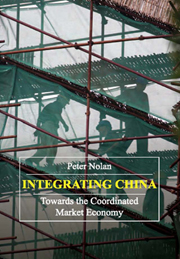Book contents
- Frontmatter
- Contents
- Acknowledgements
- Foreword
- 1 Reflections on 4th June 1989
- 2 The Global Business Revolution and Developing Countries
- 3 The Globalisation Challenge and the Catch-up of Developing Countries: The Case of the Brewing Industry
- 4 The Global Industrial Consolidation and the Challenge for China: The Case of the Steel Industry
- 5 China in the Asian Financial Crisis: ‘Cutting the Trees to Save the Forest’
- 6 China at the Crossroads
- 7 Capitalism and Freedom: The Contradictory Character of Globalisation
- 8 Capitalism, Conflict and Cooperation: US-China Relations under Capitalist Globalisation
- Index
5 - China in the Asian Financial Crisis: ‘Cutting the Trees to Save the Forest’
Published online by Cambridge University Press: 05 March 2012
- Frontmatter
- Contents
- Acknowledgements
- Foreword
- 1 Reflections on 4th June 1989
- 2 The Global Business Revolution and Developing Countries
- 3 The Globalisation Challenge and the Catch-up of Developing Countries: The Case of the Brewing Industry
- 4 The Global Industrial Consolidation and the Challenge for China: The Case of the Steel Industry
- 5 China in the Asian Financial Crisis: ‘Cutting the Trees to Save the Forest’
- 6 China at the Crossroads
- 7 Capitalism and Freedom: The Contradictory Character of Globalisation
- 8 Capitalism, Conflict and Cooperation: US-China Relations under Capitalist Globalisation
- Index
Summary
Introduction
In December 1997, shortly after the onset of the Asian Financial Crisis (AFC), the Chinese Central government sent Wang Qishan, then president of the China Construction Bank, to become a member of the Guangdong provincial party committee. One month later, he was appointed executive vice-governor of the province. The Guangdong provincial party committee subsequently set up the ‘Five-member team to deal with financial crisis’. Its main task was to deal with the intensifying payment crisis in Guangdong. Two of the flagship companies of Guangdong, Guangdong International Trust and Investment Corporation (GITIC) and Guangdong Enterprises (GDE), were insolvent and unable to survive. After intense debate, the Guangdong government decided to bankrupt GITIC and restructure GDE. These events caused an outcry in the international press. International creditors had wished to believe that regardless of the fate of the enterprises, the Chinese government would pay in full the international debts as it had normally done in the past.
In October 2000, after intense debate and tough negotiation, GITIC repaid US$ 85 million at the third creditors' meeting. In December 2001, the International Financial Review awarded GDE the title of ‘Asia's best debt restructuring project’. Subsequently, a much less-publicised event was the fact that by borrowing RMB 45 billion from the central government, the Guangdong provincial government had been able to restructure and close more than 800 local small and medium non-bank financial institutions.
- Type
- Chapter
- Information
- Integrating ChinaTransition into Global Economy, pp. 95 - 144Publisher: Anthem PressPrint publication year: 2007

